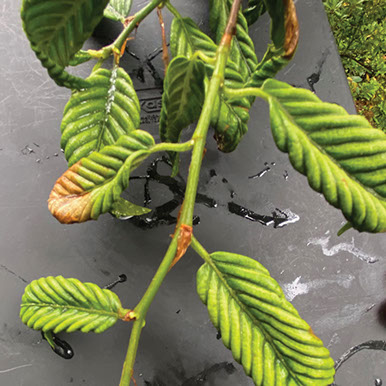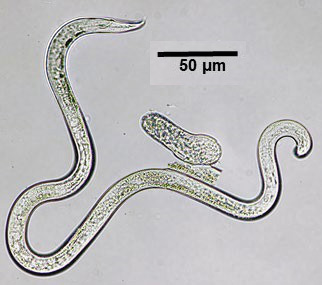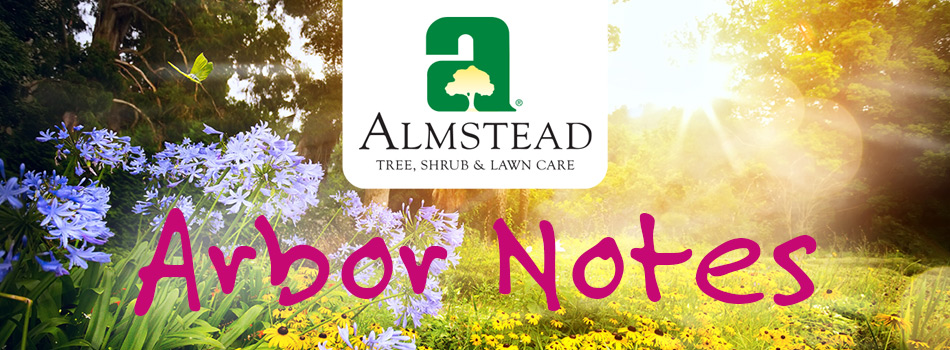The science of preserving nature since 1964
An Emerging Lethal Disease for Beech Trees
Beech Leaf Disease (BLD) is a new and devastating disease suspected to be caused by a nematode, or microscopic worm. This foliar-feeding nematode, Litylenchus crenatae mccannii, causes the infected portions of the leaves to shrivel up and die, leading to a decreased ability to photosynthesize, deteriorating overall health and vigor and eventually exposing the tree to secondary insect pests and disease. Healthy trees progressively weaken from the disease and die in a span of 2-6 years (depending upon the size of the tree from the onset of symptoms.
All cultivars of American, European as well as Oriental beech are susceptible. The disease was first observed in northeastern Ohio in 2012. Since this first detection, the disease has rapidly spread and is now identified throughout Ohio, Pennsylvania, New York, Connecticut, and Ontario – it is certain to be in New Jersey soon, if it is not already. The pest may have been present over the last 2-3 years in our region, but symptoms are only being diagnosed and seen now.
Beech is a dominant species in the forests of the eastern United States and a common feature tree in our landscapes. So, it is with great displeasure as arborists and stewards of the environment that we bring you this unfortunate alert.
SYMPTOMS OF BLD
The most characteristic symptom of BLD is a dark green coloration in bands between leaf veins (Image 1 & 2). It appears to begin on lower portions of the canopy but can be found scattered about. With time, these leaves become deformed, chlorotic, and develop a thickened, almost leathery texture (Image 3 & 4). The interveinal discoloration will appear cupped or puckered in appearance (Image 3 & 4). The capacity of the tree to produce carbohydrates is greatly compromised at this stage and leaves wither, dry and turn yellow before falling off making the canopy of the tree thin and open (Image 5) — and susceptible to opportunistic insects such as two-lined borer, ambrosia beetle and several fungal cankers.

1

2

4


3
5
THE CAUSE OF BLD
 Scientists and researchers believe the causal agent as described above is the unique foliar-feeding nematode Litylenchus crenatae (Image 6), which has been repeatedly found and associated with the symptoms in the U.S. This nematode was identified in 2018 in Japan on Japanese beech and is believed to be native to Japan and other parts of Asia. The damage appears to occur while the leaf tissue is in bud making it more difficult for treatment options in reducing nematode populations. It is also possible that an unknown microbe is being vectored by this nematode. These nematodes can move in shallow films of water or can hitch a ride on anthropods (e.g., spider mites) to spread locally. It has been suggested that they even travel on birds over long distances and spread the disease, as well as through the transport of nursery stock. In seeing how quickly the infestation has spread from one season to the next, we suspect it may even be possible for these nematodes to travel by wind although no evidence is at hand presently to support this.
Scientists and researchers believe the causal agent as described above is the unique foliar-feeding nematode Litylenchus crenatae (Image 6), which has been repeatedly found and associated with the symptoms in the U.S. This nematode was identified in 2018 in Japan on Japanese beech and is believed to be native to Japan and other parts of Asia. The damage appears to occur while the leaf tissue is in bud making it more difficult for treatment options in reducing nematode populations. It is also possible that an unknown microbe is being vectored by this nematode. These nematodes can move in shallow films of water or can hitch a ride on anthropods (e.g., spider mites) to spread locally. It has been suggested that they even travel on birds over long distances and spread the disease, as well as through the transport of nursery stock. In seeing how quickly the infestation has spread from one season to the next, we suspect it may even be possible for these nematodes to travel by wind although no evidence is at hand presently to support this.
MANAGEMENT OF BLD
Preventive and therapeutic treatments for BLD are still in the early stages but avoid moving beech trees from areas where there are known infestations in the meantime to prevent its spread. Several products with nematicidal properties are being explored in combination with supplemental treatments to assist with health and vigor, and to control secondary opportunistic pests as options for management. Preliminary research data also indicates that trees treated with TREE-age® may have significantly fewer nematodes compared to untreated trees — however, due to susceptibility to phytophthora and other pathogens we are currently limiting this option and performing it in conjunction with other treatments based on efficacy. If you are unsure whether you have beech trees on your property or would like to review treatment options, please contact your local arborist.
6
PLEASE NOTE:
The treatments being proposed here are not yet proven and clients should be aware that recommended program options are being performed on a trial basis. If we become aware of additional protocols from state agencies or scientists, the client will be notified. There is no guaranteed success yet for this treatment for BLD. Our goal at this time is to reduce nematode populations and to increase the health and vigor through various care practices to extend the life of healthy beech trees until additional research and options become available.
For more information on Beech Leaf Disease in your region, please visit the following links:
- New York Department of Environmental Conservation (DEC)
- New Jersey Department of Parks and Forests
- The Connecticut Agricultural Experiment Station

LOCATIONS:
Lower Westchester County, NY and New York City
58 Beechwood Ave, New Rochelle, NY 10801
914-576-0193
Upper Westchester (North of I-287)
15 Broadway, Hawthorne, NY 10532
914-741-1510
Fairfield County, Connecticut
547 Hope Street, Stamford CT 06907
203-348-4111
Bergen & Passaic Counties, NJ
504 High Mountain Road, North Haledon, NJ 07508
973-636-6711
Contact us for a Free Consultation
